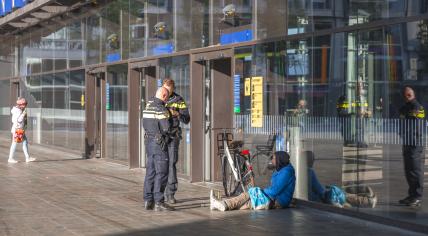
Some 30,600 homeless adults in Nehterlands last year; Very worrying, State Sec. says
In the Netherlands, an estimated 30,600 people between 18 and 65 had no roof over their heads last year. That is more than in 2022, when an estimated 26,600 people in that age category were homeless. Still, due to uncertainty margins, it is too early to speak of an increase, Statistics Netherlands (CBS) reported. “Since 2018, the number of homeless people between 18 and 65 continually declined,” said CBS researcher Tanja Traag. “You can at least say that decline has now stopped or that the number of homeless people has stabilized.”
Outgoing State Secretary Maarten van Ooijen (Public Health, Welfare, and Sports) called the increase in the number of homeless people “very worrying, unacceptable, and the opposite of what we want.” He does not find it too soon to speak of an increase, as CBS does.
A precise reason for the halted decline in homelessness is difficult to give, according to CBS. “But there are issues that can play a role, such as current issues regarding housing and facilities for migrant workers,” Traag said. Of the homeless 18 to 65-year-olds last year, 8 percent were not born in the Netherlands but in another European country. In 2022, that was still 5 percent. “That does not mean that these are all migrant workers, but it is obvious that it does play a role.”
To estimate how many people are homeless in the Netherlands, CBS first counts the number of homeless people registered somewhere. For example, people known to the probation service, people who have a postal address at a shelter, or receive social benefits for adressless persons. The statistics office then also estimates how many people do not appear in such administrations but are homeless, such as people sleeping on the streets.
According to CBS, homeless people under the age of 18 or over 65 are not included in the estimate because they don’t appear in the social assistance register due to their age. Although the state pension age has been set at 67 years and homeless 66 and 67-year-olds are therefore eligible for social assistance benefits, CBS does not yet include that age category in its estimate. That is to prevent a trend break, Traag explained. It would then no longer be possible to make a comparison with previous years, she said. CBS is working on a solution for this.
Last year, shelter organizations criticized CBS’s homelessness figures, which showed a decrease in the number of homeless 18 to 65-year-olds. According to many organizations, the number of homeless people was increasing, especially among children under 18 and people over 65. The organizations argued for a different counting method.
State Secretary response
Outgoing State Secretary Maarten van Ooijen (Public Health, Welfare, and Sports) called the increase in the number of homeless people “very worrying, unacceptable, and the opposite of what we want.” He said: “If we do not take further action now, the number of homeless people will only increase, and the associated problems will become greater.”
“Unfortunately, the increase does not come as a surprise,” said the State Secretary. “It is in line with what I have already indicated in various media in recent months. It also confirms the signals that field parties have also stated in the past period. They indicate that the number of people sleeping outside and people using a shelter is increasing.”
Van Ooijen suspects that “the consequences of the war in Ukraine, high inflation, and a still overheated housing market are now clearly visible in the figures.” He said the increase shows how “urgent the problem of homelessness is.” Preventing homelessness is essential, as is providing prompt guidance if people do become homeless. “Recovery starts with a home.’
At the end of 2022, the State Secretary launched the National Homelessness Action Plan. Various ministries, municipalities, healthcare parties, and housing associations teamed up to prevent homelessness. With that plan's further development and implementation, all these parties want to “reverse the trend,” said Van Ooijen. “But that does not happen automatically. Municipalities and field parties notice that tackling the problem is difficult and that the changes take time.”
The Salvation Army said that it is “severely disappointed” with the increase in homelessness. The aid organization called on the new Cabinet to provide at least 10,000 additional places for people without homes to live as quickly as possible and also to find a structural solution. “The formation parties are currently talking about public housing and must make this a top priority,” said board chairman Harm Slomp. According to the Salvation Army, more living space can be created by sharing homes and converting vacant buildings into residential units.
Reporting by ANP
